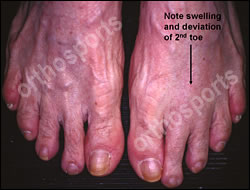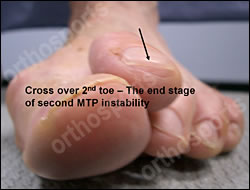Inside This section
Mechanical 2nd MTP Synovitis
Overview
This is a very common condition occurring in males and females of all age groups.
The condition is thought to occur because the 2nd metatarsal is the longest and when patients take excessive stress, such as walking or running through the forefoot region. The ligaments of the 2nd MTP joint become lax and the joint becomes unstable. Patients present with pain which can be described as “burning” or “aching”. The pain is invariably activity related and later in the condition the patient may report deviation of the toe or occasionally crossover of the toe.
A spectrum is now thought to exist between second MTP synovitis and cross over 2nd toe – see slides below…


Initially plain x-rays taken are normal. The diagnosis is a clinical one and although it can be confirmed by ultrasound or MRI scan, these investigations are rarely necessary.
In the past many patients with mechanical 2nd MTP synovitis were misdiagnosed as neuromas.
Recommended Treatment
Initially the condition responds to taping of the toe with a weight relieving insert in the shoe. Cortisone injections can be helpful, but must be performed judiciously to ensure that the 2nd MTP joint is not over distended and dislocation does not occur.
Approximately 70% of patients can be managed non surgically; the remainder will require a surgical procedure. The most common surgical procedures performed, in our practice, are either shortening osteotomies or tendon transfer. Surgery is generally effective 80% – 90% of the time.
